Presented by the
Newfoundland's Grand Banks Site
to assist you in researching your Family History
Click on the graphic below to return to the NGB Home Page
To contribute to this site, see above menu item "About".
These transcriptions may contain human errors.
As always, confirm these, as you would any other source material.
|
In the last chapter we have followed the operations of the Regiment up to October 1916. The remaining days of 1916, and practically all the first month of 1917 were spent in rest camp. That was the period of reconstruction, and of preparation for the severe battles of the following spring. The British campaign of 1916 ended with the brilliant victory on November 13, at Beaumont Hamel, which resulted in the capture of that very important position. The name has a special significance for Newfoundlanders, but let no one think that its final capture casts any reflection on the courage and ability of our own Regiment. Its capture was the outcome of practically five months’ flanking operations in which upwards of fifty divisions took part, most of them more than once. The position was approached from a different and less difficult direction, and was defended by a less efficient foe. The period of comparative quiet during the winter months was welcomed as a reconstruction period. Our Regiment had taken part in two important actions of the “First Battle of the Somme,” and had incurred heavy casualties. The task of reconstructing was not a light one, but it was begun with unshaken courage and carried out with great enthusiasm, and when the Kaiser’s birthday came along the Newfoundland Regiment was prepared to give him the kind of present that, from the standpoint of humanity and democracy, he most needed. LesBoeufs. The Regiment had spent an enjoyable Christmas in a quiet French village and was in splendid shape, when in the latter part of January it moved into the line at LesBoeufs. The roads were frozen and in many places covered with ice, and on the morning of the twenty-seventh, when the Kaiser’s birthday box was to be presented, the ground was covered with snow. The action was timed for half past five in the morning. Our Regiment was in reserve, but, when to the second, every gun was fired and the thunderous noise seemed to shake the whole battlefield, the Newfoundland Regiment insisted on taking part in the greeting. Page Fifty-Three The terrific bombardment lasted for more than an hour, and the enemy became nervously excited. All kinds of distress signals were sent up from the German lines. The whole area, for miles along the enemy front line, was lit up with large flares, and the advance of our troops as well as the activities of the enemy could be seen as clearly as in broad daylight. Without any orders some companies of our Regiment followed close on the heels of the attacking troops, and soon found themselves up to the enemy trenches. It happened that our attacking troops had advances so quickly over the enemy front line of trenches, and probably at a time when the flares were not being sent up, that many enemy troops had escaped their notice and had organized themselves into a strong party when some of our Regiment came up to the trench. Had their plans not been forestalled these would have been a serious menace to our troops which had gone behind the trench. 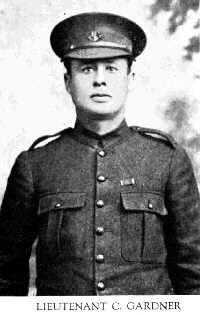
As he was marching his capture back to our lines a British officer charged down on them. The officer was about to fire on the prisoners when Gardner stopped him, and it is said, told him that if he shot one of the Germans he would get shot himself. When a German officer, who was among the captured soldiers, saw Gardner’s action he took the Iron Cross from his own breast and pinned it on Gardner’s. In this engagement a number of the Newfoundlanders acted as stretcher-bearers. Their capacity for this work was not surpassed by any unit in the British army, and whenever they were available they were sought for this duty. It required faithfulness when subject to the severest shell- fire. In this action they rendered invaluable services and suffered some losses. Seven men were killed and 179 were wounded. German Retreat. Our Regiment was not again brought into conflict with the enemy until shortly after their general retreat in the latter days of February and the early part of March. The positions held by the Germans became untenable after the splendid victories of the British armies in the First Battle of the Somme. On February 25, the whole German front both north and south of the Ancre caved in for a depth of over three miles. The enemy retreat to their great permanent second line was orderly and skilful, and the most unfavorable weather conditions prevented the pursuit by the British armies being anything but slow and tedious. In many places also the advance of the troops was strongly opposed, and all kinds of devices were used to obstruct their onward flow. Gradually the enemy retreat spread south, and on March 3, after scarcely more than a month of usual periodic trench duty and rest camp life, our Regiment was drawn in to an important action at Saill-Saillisel, better known to the Regiment as “Silly, Silly, Sal,” just south of Gueudecourt. Saill-Saillisel. The action was preceded by a terrific bombardment by the enemy of the position occupied by the Newfoundland Regiment. The bombardment started at 7 o’clock on the morning of March 3, and continued with increasing intensity for more than an hour. It is to the honor and glory of the famous Twenty-Ninth Division that they never lost a trench, but on this occasion the record was nearly broken. The Regiment was faced with some very active enemy brigades whose movements were concealed by a heavy mist and the use of smoke bombs. A party of about 50 enemy troops advanced on each side of the trench occupied by our men and was within about 700 yards before they were discovered. Page Fifty-Five The situation called for quick action. Quite a number of our men, including the platoon commander at that point, were so severely wounded during the bombardment that they were put out of action. A non-commissioned officer, who attempted to fire rockets as signals for aid, was severely wounded before he could send up more than two rockets. Fortunately a SOS was telephoned to headquarters before communication by telephone was cut off. Every Lewis gun except on e was put out of action. Bombs were used effectively by our men, and three more Lewis guns were quickly brought up, but the enemy troops succeeded in getting into the trench and drove our men out for a distance of 40 yards, to the head of the communication trench. 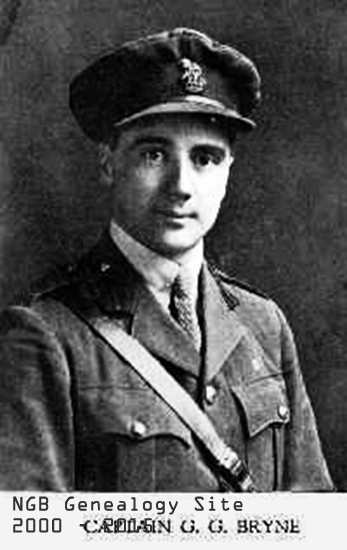
LEWIS. Two other men, Private J. P. Lewis and Lance-Corporal M. Picco, were decorated for their conspicuous bravery during this action. Private Lewis was not in the section of our trench that was attacked by the Germans. He was in the left of the trench, and was consequently considerably removed from the area of this action. As soon as he became aware of the heavy fighting in the other end of the trench and that a supply of bombs was needed, he ran back and got two boxes of bombs from the company in support. He succeeded I getting through the German barrage with one lot of bombs and was returning for another supply when he was stopped by an officer who informed him that the enemy troops had been driven out. Private Lewis’ work was entirely voluntary and in his effort to relieve the hazardous situation he showed complete disregard for his personal safety. PICCO. Lance-Corporal Picco fought through the whole day under tremendous physical handicaps. He was in the right of the Plaz trench where the enemy first attacked. He was wounded by a German bomb that put a Lewis gun out of action, but he continued bombing through the whole engagement, getting supplies of bombs from the company in support. He got his men together and counter- attacked at about the same time that Lieutenant Byrne began pushing the enemy back with his bombing party. When they had consolidated their gains Lance-Corporal Picco remained in charge of the advance position until his party was relieved during the night. Next day it was found that in addition to the wound received from a German bomb he had a severe attack of trench feet, and in that condition had fought through the entire day. His faithful, never-say-die leadership contributed largely to the splendid success of our Regiment at Saill-Saillisel. Our casualties in this action amounted to thirteen killed and thirty-nine wounded. The Battle of Arras. The Regiment’s next engagement with the enemy was destined to be one of much greater magnitude. Sir Douglas Haig had been preparing for some months, from the time of the glorious avenge at Beaumont Hamel, to strike a heavy blow at the enemy in Belgium, extending from the neighborhood of Lens in the north to Arras in the south, a distance of about twelve miles. The preparations included a tremendous concentration of artillery and roughly, 120,000 men in the storming line and 40,000 in support. Page Fifty-Seven 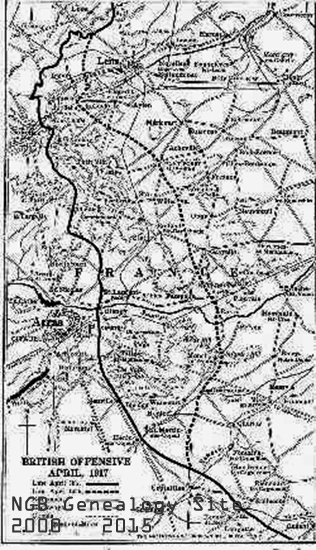
The Newfoundland Regiment reached Arras on Easter Monday. It was not until the night of the twelfth, however, when the Battle of Arras had reached the end of its fourth day of desperate fighting, that the Twenty-Ninth Division took its turn in the front line of attackers I front of the village of Monchy-le-Preux. This village was captured by the Thirty-Seventh Division on the eleventh. The thirteenth was a comparatively quiet day for our men. No large forward movement was planned in this section, and the whole area from north of the Cojeul River to the south of the Scarpe was held by the Twenty-Ninth and the Seventeenth Divisions, the Twenty-Ninth to the south and the Seventeenth to the north. At about 5:30, on the morning of the fourteenth, both divisions advanced for the purpose of testing the enemy strength, and, if possible, to push them farther back from Monchy. Their efforts were unsuccessful, but the Newfoundland Regiment added new honors to its already splendid records at Beaumont Hamel and Gueudecourt. The Advance. The plan of the attack was that the 88th Brigade, which consisted of the Newfoundland Regiment, the 1st Essex, the 2nd Hants, and the 4th Worcesters should advance in a direction about east from Monchy, on a front of about 500 yards. Another brigade of the Twenty-Ninth Division was to advance at their right and the Seventeenth Division at their left. The attacking troops had not gone far before they were subject to a strong German counter-attack and a murderous shell-fire from the enemy guns. As they advanced, enemy machine guns were turned on them with terrible results. Despite the heavy shell and machine-gun fire, however, our Regiment reached part of its objective, though heavy losses were sustained in so doing. The brigades which were supposed to advance on the right and on the left of the 88th suffered severely from the German barrage and before they could advance they were held up by the on-rush of enemy troops. Page Fifty-Eight Some of our men reached the enemy trench, but no sooner had they done so than they saw strong parties of enemy troops advancing on both sides. Before they had time to realize the situation two whole companies of our Regiment were hemmed I and were being fired on from all sides. Escape was impossible. Small parties of our men fought against whole companies of the enemy until many of them were severely wounded and they were obliges to give themselves up. All communication by telephone had been cut, but at about half past nine, a private of the Essex Regiment ran into headquarters and reported that the Newfoundland Regiment had been wiped out. Lieutenant Keegan was immediately sent out to find out what the exact situation was and bring back a report. He saw the Germans coming along victorious, only about 250 yards away. Every man available at headquarters was quickly collected together, and, led by Lieutenant-Colonel Forbes-Robertson, the little party of sixteen men rushed out, collecting weapons and ammunition from dead or wounded soldiers as they went, determined, if possible, to hold up the Germans until reinforcements arrived. A company of the 2nd Hants, which had been brought up by a lieutenant of the Essex Regiment, defended the northern flank and prevented the enemy troops from getting around in that quarter. The small headquarters’ party, which had been reduced to nine when they reached the edge of the village, established themselves in a grove of trees just outside the village, and every German who came up was shot. The nine men held the grove from 10 o’clock in the morning until 4 in the afternoon, and at times they were obliged to keep up a rapid fire in order to ward off the enemy and keep information as to the number by which the important position of Monchy was defended concealed from them. German scouts which were sent out never returned; and it is obvious that had one scout returned with information as to the exact situation Monchy would have been lost, and quite probably the victories of the previous four days together with the months of preparation that made the victories possible would have been in vain. Regarding this engagement Sir Arthur Conan Doyle says: “It was an unsuccessful day, and yet it was one of those failures which will be remembered where facile successes have been forgotten, for it brought with it one episode which elicited in the highest degree the historical qualities of British Infantry.” It was later discovered that our Regiment and the Essex Regiment had held up the advance of a strong German counter-attack by a whole Bavarian Division with the intention of retaking Monchy. The Newfoundland Regiment simply declined to be beaten. Page Fifty-Nine Its courage stubborn resistance and willing sacrifice undoubtedly saved Monchy, and probably the whole splendid success of the Battle of Arras. Regarding the Headquarters’ Staff Captain (Reverend) Nangle said in his lecture on the work of the Regiment: “Lieutenant-Colonel Forbes-Robertson and his eight men are the men who saved Monchy. They won fame for themselves; they won fame for the Regiment. The whole British army in France honors the names of these nine men for their heroic conduct.” 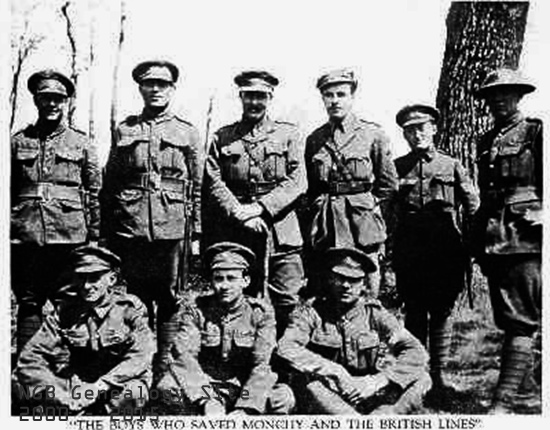 Top row, left to right: Lieut. Albert Rose, Pte. Walter
Pitcher, Lieut.Col. J. Forbes-Robertson, Capt. Kevin Keegan, Sergt. Charles
Parsons, Sergt. Ross Waterfield. Bottom row, left to right: Pte. Fred Curran,
Staff Sergt. John J. Hillier, Lance-Corpl. Japheth Hounsell.
Top row, left to right: Lieut. Albert Rose, Pte. Walter
Pitcher, Lieut.Col. J. Forbes-Robertson, Capt. Kevin Keegan, Sergt. Charles
Parsons, Sergt. Ross Waterfield. Bottom row, left to right: Pte. Fred Curran,
Staff Sergt. John J. Hillier, Lance-Corpl. Japheth Hounsell.Our Regiment suffered heavily in this action. The casualties included Sergeant-Major Gardner, whose splendid achievement at LesBouefs has already been mentioned; Captain Rowsell, and Lieutenants Stevenson, Smith and Outerbridge. Fortunately most of the losses were in prisoners who were rehabilitated after the armistice. Forty-nine men were reported killed, 142 wounded, and 296 missing. A number of decorations were awarded for heroic and valuable services, but one can well imagine that many of those who advanced to the German trench earned decorations, but because their heroic sacrifice and gallant resistance were not witnessed, except by the enemy who were held up and suffered severe losses in consequence, the distinguished conduct could not be reported. Les Fosses Farm. As in the First Battle of the Somme, so in the Battle of Arras, our Regiment was destined to take part in two important engagements. Only nine days after the action at Monchy-le-Preux, the advance along the British line was renewed, and the Regiment was brought in to conflict with the enemy at Les Fosses Farm, a short distance to the south-east of Monchy. Other battalions of the 88th Brigade formed the van of the attack, but during the day, when a severe counter-attack was launched by the enemy against the positions taken by the 88th and 87th Brigades, our men were drawn into the fight. 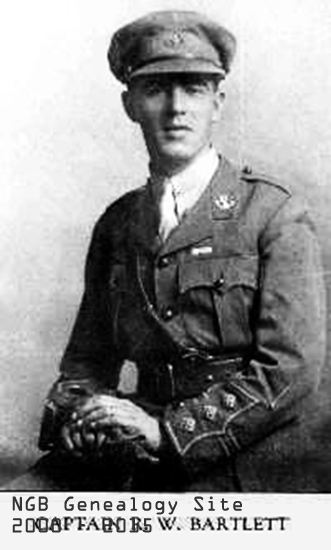
During the two engagements the whole Twenty-Ninth Division gave a splendid account of itself, and suffered severe losses. Our Regiment lost in killed, wounded and missing, 550 men of all ranks. It will be seen that from the standpoint of numbers, the Regiment was too weak to take its position in the front line as a unit until it could be built up with fresh drafts from England. During the first part of 1917, which was occupied with the four engagements that we have reviewed in this chapter, the record of the regiment was a splendid exhibition of true soldierly fighting qualities. Never did a unit display greater valor and more persistent resourcefulness than did the Newfoundland Regiment at Monchy. In every engagement the men showed such initiative and ability as could be expected only from soldiers of much longer experience, and an eagerness and cheerfulness that were admired by all with whom they came in contact. Their record in each action stands out as unquestionable testimony of the real fight-to-conquer spirit by which they were impelled, and the courageous, resourceful manner in which they handled the most trying and difficult situations. The severe losses which they had suffered almost 800 in killed, wounded and missing, indicate the willingness with which they were prepared to sacrifice themselves in order that victory be obtained, and the honor of the Regiment and the fame of their country increased. The following decorations were awarded for conspicuous bravery and devotion to duty during the period reviewed in this chapter:
|
Return to the Main Military Records Index
Military Records Contact: Sherwin Flight
Newfoundland's Grand Banks is a non-profit endeavor.
No part of this project may be reproduced in any form
for any purpose other than personal use.
JavaScript DHTML Menu Powered by Milonic
© Newfoundland's Grand Banks (1999-2025)
Hosted by
![]()
Your Community, Online!
![[Recent]](../../recent.gif)
![[Home]](../../home.gif)